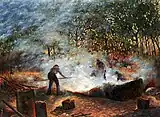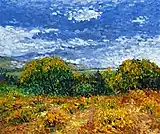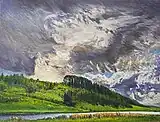Gholamhossein Saber | |
|---|---|
غلامحسین صابر | |
 Saber in 2018 | |
| Born | 20 December 1941 |
| Nationality | Iranian |
| Education | Bachelor of Arts in History and Geography |
| Alma mater | Shiraz University |
| Known for | Painting, photography, teaching art |
| Style | Realism, expressionism, impressionism, post-impressionism |
| Spouse | Zahra Entezari |
| Children | Nima Saber, Omid Saber |
Gholamhossein Saber (Persian: غلامحسین صابر; born 1941), is an Iranian artist known for painting, photography, and teaching art.[1] Saber's art spans a wide range of styles from Realism and Expressionism to Impressionism and Post-Impressionism. His primary subject matters are portraits, mostly of ordinary people, and Impressionist landscapes from southern Iran.[2][3][4]
Early life and education
Saber was born in 1941 in Shiraz, Iran, to Mohammad Hassan and Rezvan Saber. His great grandfather, Mirza Mehdi Saber, who was contemporary with Mohammad Shah Qajar and Naser al-Din Shah Qajar, was a poet and a calligrapher.[1] Saber's talent and interest in painting was noticed by his school teachers from an early age.[4] While still in grade 10, he was convinced he wanted to become an artist. At the suggestion of his sister, he enrolled in weekly private lessons with Khalil Negargar, a Shirazi painter indirectly influenced by Kamal-ol-molk. Negargar taught him the basics of making oil paint from color pigments, building canvases, and copying from the old masters' works, a common practice among the painters of that period in Iran.[5] He also recounted stories about the great painters, particularly Raphael, Titian, and Rembrandt, inspiring the young student and further fanning the flames of his passion for art.[4] In a group exhibition of students works, where Saber had submitted a copy of a portrait by Repin, he met Jahangir Mehraban-poor, a medical student and a friend of Saber's sister. Jahangir was a well-read person, knew English, and painted in his free time. Jahangir told Saber that copying was a waste of time and encouraged him to draw and paint from real life and the people on the street. The two became friends and started going out for live sketches.[4]
In 1960, after finishing high school, Saber was admitted to the History and Geography Bachelor's program in the Faculty of Literature of the Shiraz University. The university's scholarly and innovative environment offered him a broader and deeper perspective of the world. He made new friends among the university students, discovered writers he didn't know about before, and got familiar with classical music. Starting in 1960, the University of Pennsylvania was assisting the Iranian government in modernizing Pahlavi University based on American-style higher education.[6] Consequently, the university's central library was going through a major upgrade, acquiring large collections of English books, including a large number of books on visual arts. Saber spent a lot of time in the library, studying the works of the old masters. Gradually, he became acquainted and fascinated with the Impressionists, particularly Monet, and Camille Pissarro.[4]
Saber graduated with a B.A. in History and Geography in 1964. The next year he completed a one-year program at the Tehran Teacher Training University (later renamed to Kharazmi University) to qualify for employment by the Ministry of Education.[7]
Career
Upon completion of the program in 1965, he was hired as a high school teacher by the Ministry of Education and was transferred to Khoramshahr, a small inland port city on the eastern shore of the Karoun river. The three years he spent in Khorramshahr were very critical in his career development as an Impressionist artist. At the same time, the paintings from that period have a strong Realistic and Expressionist bent and reflect the struggles and the sufferings of the people within the vast and rich landscapes of the South.[4]
In 1968, he was transferred to his hometown, Shiraz, and started teaching art, history, and geography at Mehrayeen and Shapoor high schools. He continued painting in his free time. As in the Khorramshahr years, his early Shiraz works, especially his portraits, with darker colors and strong brush strokes, had a certain Expressionistic look. Starting with mid-seventies, he gradually abandoned that approach. His colors become more vivid and he developed a refined, Pre-Raphaelite-like, style, while employing an Impressionist palette.[4][8][9] During the eighties, this disposition towards more vivid and pure colors continues and solidifies into a unique Impressionist and Pointillist style owed as much to the blazing Sun and the dazzling sky of the Fars province.[10]
Teaching art
In October 1968, the Ministry of Arts and Culture opened a cultural center on Ferdowsi street in Shiraz. The general director of the ministry in the Fars Province, Nasser Kojoori, asked Saber to join as the painting instructor. The center was called the House of Culture Number One (Persian: خانه فرهنگ شماره یک). This was the beginning of Saber's secondary arts-related career as a painting teacher. Anyone who showed interest in painting could join the classes. Apart from drawing and painting techniques, the classes included art theory and art history sessions, as well as casual talks and discussions on literature, photography, cinema, and classical music.[4] For 32 years Saber trained hundreds of students, many of whom have become accomplished artists and art instructors.[11] In 2000, Saber retired from teaching at the public center and with his wife Zahra Entezari opened the Ofogh private art school. He continued teaching there for almost 20 years.[5]
Photography
Saber became familiar with photography when he was a university student. Initially encouraged by Yeprem Artonians, aka Monsieur George, who ran a photography studio in Shiraz, he gradually became more vested in photography, following it with the same dedication as he did painting. The subjects of his photographs, similar to his paintings, range from still lives to portraits and countryside landscapes.[12][4] In 2003 he had a show of his photographs in the Sabz Gallery in Tehran.[13]
Awards and recognition

Saber was born and lived the first 60 years of his life in a 200-year old heritage building in a historic neighborhood in Shiraz. In 2001, the Fars provincial government purchased this house and 20 of Saber's works in order to turn it into a museum. In 2003 a ceremony was held and the museum was officially opened to the public. Unfortunately this did not last long and within a few years the works were moved to an unknown location and the museum was closed.[5]
In the Spring of 2005, the Meshkinfam Art Museum in Shiraz held a retrospective of Saber's works in recognition of his lifetime contributions to Shiraz' art.[14]
In 2019, an official ceremony was held by the Ministry of Islamic Culture and the City of Shiraz to honor Saber's contribution to the Fars province's art and culture. This coincided with unveiling the book on Saber's selected works, "A Paradise of Light and Color", and a postal stamp in the artist's commemoration. [15]
Early works
 Old Woman, 1963, Oil on canvas
Old Woman, 1963, Oil on canvas Villagers Huts in Khoramshahr, 1965, Oil on canvas
Villagers Huts in Khoramshahr, 1965, Oil on canvas Boat on Karun, 1966, Oil on canvas
Boat on Karun, 1966, Oil on canvas Boats on Karun, 1966, Oil on canvas
Boats on Karun, 1966, Oil on canvas The Gamblers, 1966, Oil on canvas
The Gamblers, 1966, Oil on canvas Still Life, 1971, Oil on canvas
Still Life, 1971, Oil on canvas Madman, 1972, Oil on canvas
Madman, 1972, Oil on canvas
Impressionist works
 Sara, 1975, Oil on canvas
Sara, 1975, Oil on canvas Girl in the Studio, 1976, Oil on canvas
Girl in the Studio, 1976, Oil on canvas Rokhsareh, 1976, Pastels
Rokhsareh, 1976, Pastels Self Portrait, 1977, Oil on canvas
Self Portrait, 1977, Oil on canvas Thorns, 1980, Oil on canvas
Thorns, 1980, Oil on canvas Zahra, 1981, Oil on canvas
Zahra, 1981, Oil on canvas Asphalt Workers, 1983,Oil on canvas
Asphalt Workers, 1983,Oil on canvas Sunset, 1984, Oil on canvas
Sunset, 1984, Oil on canvas In the Garden, 1986, Oil on canvas
In the Garden, 1986, Oil on canvas Nomad Women, 1987, Oil on canvas
Nomad Women, 1987, Oil on canvas Leila, 1988, Oil on canvas
Leila, 1988, Oil on canvas Posht-e-Moleh, 1988, Oil on canvas
Posht-e-Moleh, 1988, Oil on canvas Portrait of Zahra, 1988, Oil on canvas
Portrait of Zahra, 1988, Oil on canvas Fig Tree, 2004, Watercolor
Fig Tree, 2004, Watercolor Autumn, 2005, Oil on canvas
Autumn, 2005, Oil on canvas Winter, 2005, Oil on canvas
Winter, 2005, Oil on canvas Leila K. 2007, Oil on canvas
Leila K. 2007, Oil on canvas A Landscape, 2011, Oil on canvas
A Landscape, 2011, Oil on canvas North West Landscape, 2019, Pastels
North West Landscape, 2019, Pastels Self Portrait, 2019, Pastels
Self Portrait, 2019, Pastels Country Kids, 2020, Pastels
Country Kids, 2020, Pastels Country Girls, 2020, Pastels
Country Girls, 2020, Pastels Stormy Clouds, Calgary, 2021, Oil on canvas
Stormy Clouds, Calgary, 2021, Oil on canvas Doshman-Ziyari, 2021, Pastels
Doshman-Ziyari, 2021, Pastels
Exhibitions
- Vesal Gallery, Shiraz, Iran, 2019[16]
- Meshkinfam Art Museum, Shiraz, Iran, 2005[14]
- Sabz Gallery, Tehran, Iran, 1997[12]
- Seyhoun Art Gallery, Tehran, Iran, 1983[17]
- Group show at Sheikh Art Gallery, Tehran, 1977[10]
- Vesal Art Gallery, Shiraz, 1977[5]
- Vesal Art Gallery, Shiraz, 1975[10]
- Exhibition at Faculty of Literature in Shiraz University, Shiraz, 1963[5]
References
- 1 2 "بیوگرافی استاد غلامحسین صابر" [Artist Gholamhossein Saber's Biography]. Khabar Newspaper (in Persian). Shiraz, Iran. 2005.
- ↑ Dalvand, Ahmadreza (1993), "از شیراز تا شیراز با رنگ" [From Shiraz to Shiraz with Color], Donyaye Sokhan (in Persian), Tehran
- ↑ Alkhas, Hannibal (1977-02-02). "بازگشت صابر به غم کم رنگی ها" [Saber's Return to the Sorrow of the Greys]. Kayhan Newspaper (in Persian). Tehran.
- 1 2 3 4 5 6 7 8 9 Mourizi-nejad, Hassan. "غلامحسین صابر" [Gholamhossein Saber]. Iran Banou (in Persian). Tehran. Retrieved 2023-04-01.
- 1 2 3 4 5 Mourizi-nejad, Hassan (2019). گزیده آثار غلامحسین صابر (بهشت نور و رنگ) [Gholamhossein Saber Selected Works, A Paradise of Live Light and Color] (in Persian). Tehran: Nazar Publishing. p. 332. ISBN 978-6001522833.
- ↑ "Penn around the World: A History of Penn's Engagement with Specific Regions and Countries, University of Pennsylvania University Archives". upenn.edu. Retrieved 19 July 2022.
- ↑ Mourizi-nejad, Hassan (Spring 2018), "اتاق ارسی اولین بهانه های نقاشی. گفتگوی حسن موریزی نژاد با غلامحسین صابر" [The Room with Painted Ceiling, the First Pretext to Painting. Interview with Gholamhossein Saber], Angah (in Persian), Tehran (6)
- ↑ "گالری ها" [Galleries], Kayhane Sal (in Persian), Tehran, 1973
- ↑ Parvaz, Mohammad Ali (1992). "کلک هنر ریز" [The Artful Quill]. Khabar Newspaper (in Persian). Shiraz, Iran.
- 1 2 3 "مروری کوتاه بر زندگی و آثار غلامحسین صابر" [A Brief Review of Saber's Life and Works]. Khabar Newspaper (in Persian). Shiraz, Iran. 2005-05-19.
- ↑ Sedaghtkish, Arash (2019), "نقاشی معاصر شیراز" [Contemporary Painting in Shiraz], Herfeh: Honarmand (in Persian), Tehran (72)
- 1 2 "بیدار کردن عشق به اطایف در آدمی" [Awakening the Love for Beauty in Men]. Hamshahri Newspaper (in Persian). Tehran. 1997-05-22.
- ↑ "آمیزه نقش و عکس در ذوق آزمایی هنرمند" [The Fusion of Painting and Photography in the Artist's Experimentations]. Kayhan Havaii Newspaper (in Persian). Tehran. 1997-05-21.
- 1 2 "بزرگداشت نقاش و عکاس بزرگ شیراز استاد غلامحسین صابر" [Homage to the Great Shirazi Painter and Photographer, Gholamhossein Saber]. Tandis Visual Arts Biweekly (currently suspended) (in Persian). Tehran. 2005.
- ↑ Bahrami, Elaheh (2019-05-04). "بزرگداشت استاد غلامحسین صابر در شیراز برگزار شد" [Ceremony in Honor of Master Gholamhossein Saber Held in Shiraz]. honaronline.ir. Retrieved 2023-04-02.
- ↑ "Exhibitions of Gholamhosein Saber". galleryinfo.ir. Retrieved 7 March 2023.
- ↑ "بهار پرشکوفه کوچه باغ های شیراز در آثار استاد صابر" [The Blooming Spring in Shiraz Alleys through Saber's Works]. Ettelaat Newspaper (in Persian). Tehran. 1983-05-01.